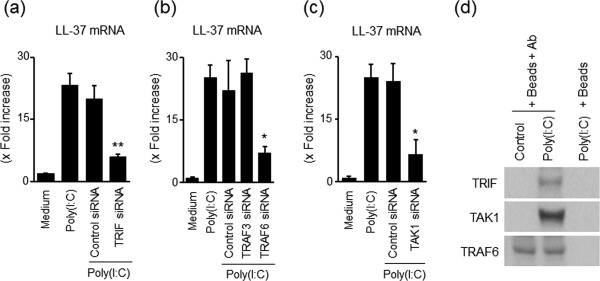Figure 3.

Role of Toll‐like receptor (TLR)‐3‐associated adaptor proteins in the induction of LL‐37 in response to poly(I:C) stimulation. (a) The effects of siRNA for Toll/interleukin (IL)‐1R domain‐containing adaptor inducing interferon (TRIF) small interference RNA (siRNA) on poly(I:C)‐induced LL‐37 mRNA expression. The cells were transfected with siRNA for TRIF or with control siRNA, and were then incubated for 12 h with or without 5 µg/ml of poly(I:C). LL‐37mRNA expression was expressed as values relative to β‐actin mRNA expression, and presented as fold increase relative to the results for medium alone (no stimulation). Data are expressed as means ± standard error of the mean (s.e.m.) of four independent experiments. **P < 0·01. (b) The effects of siRNA for tumour necrosis factor receptor‐associated factor (TRAF)6 and TRAF3 on poly(I:C)‐induced LL‐37 mRNA expression. The cells were transfected with siRNA for TRAF6, TRAF3 or with control siRNA, and then incubated for 12 h with or without 5 µg/ml of poly(I:C). Data are expressed as means ± s.e.m. of four independent experiments. *P < 0·05. (c) The effects of siRNA for transforming growth factor β‐activated kinase (TAK)1 on poly(I:C)‐induced LL‐37 mRNA expression. The cells were transfected with siRNA for TAK1 or with control siRNA, and incubated for 12 h with or without 5 µg/ml of poly(I:C). Data are expressed as means ± s.e.m. of four independent experiments. *P < 0·05. (d) Immunoprecipitation analysis of TLR‐3‐associated adaptor proteins. The cells were stimulated with 5 µg/ml of poly(I:C) for 15 min, and were then lysed with a lysis buffer. Lysates were incubated with magnetic beads (Beads) coupled with anti‐TRAF6 antibodies (Ab) or with control beads, and the precipitated proteins were then subjected to sodium dodecyl sulphate‐polyacrylamide gel electrophoresis (SDS‐PAGE) and immunoblotting to detect co‐precipitated TRIF1 and TAK1. The bottom row reveals that the precipitated TRAF6 was detected by anti‐TRAF6 antibodies, indicating equal loading dose and specificity of this system (no reaction without anti‐TRAF6 antibodies). The data are representative of two independent experiments.
